
The chimpanzee, also known as simply the chimp, is a species of great ape native to the forests and savannahs of tropical Africa. It has four confirmed subspecies and a fifth proposed one. When its close relative the bonobo was more commonly known as the pygmy chimpanzee, this species was often called the common chimpanzee or the robust chimpanzee. The chimpanzee and the bonobo are the only species in the genus Pan. Evidence from fossils and DNA sequencing shows that Pan is a sister taxon to the human lineage and is humans' closest living relative. The chimpanzee is covered in coarse black hair, but has a bare face, fingers, toes, palms of the hands, and soles of the feet. It is larger and more robust than the bonobo, weighing 40–70 kg (88–154 lb) for males and 27–50 kg (60–110 lb) for females and standing 150 cm.

Simian immunodeficiency virus (SIV) is a species of retrovirus that cause persistent infections in at least 45 species of non-human primates. Based on analysis of strains found in four species of monkeys from Bioko Island, which was isolated from the mainland by rising sea levels about 11,000 years ago, it has been concluded that SIV has been present in monkeys and apes for at least 32,000 years, and probably much longer.

The mandrill is a large Old World monkey native to west central Africa. It is one of the most colorful mammals in the world, with red and blue skin on its face and posterior. The species is sexually dimorphic, as males have a larger body, longer canine teeth and brighter coloring. It is the largest monkey in the world. Its closest living relative is the drill, with which it shares the genus Mandrillus. Both species were traditionally thought to be baboons, but further evidence has shown that they are more closely related to white-eyelid mangabeys.
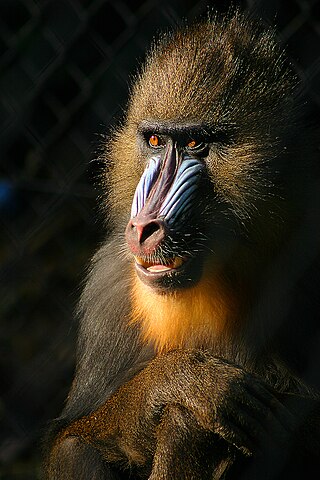
Mandrillus is a genus of large Old World monkeys distributed throughout central and southern Africa, consisting of two species: M. sphinx and M. leucophaeus, the mandrill and drill, respectively. Mandrillus, originally placed under the genus Papio as a type of baboon, is closely related to the genus Cercocebus. They are characterised by their large builds, elongated snouts with furrows on each side, and stub tails. Both species occupy the west central region of Africa and live primarily on the ground. They are frugivores, consuming both meat and plants, with a preference for plants. M. sphinx is classified as vulnerable and M. leucophaeus as endangered on the IUCN Red List of Threatened Species.
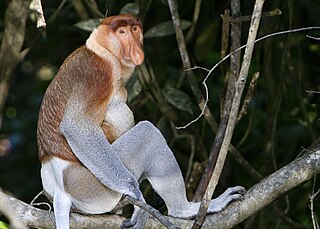
The proboscis monkey or long-nosed monkey is an arboreal Old World monkey with an unusually large nose, a reddish-brown skin color and a long tail. It is endemic to the southeast Asian island of Borneo and is found mostly in mangrove forests and on the coastal areas of the island.

The gelada, sometimes called the bleeding-heart monkey or the gelada baboon, is a species of Old World monkey found only in the Ethiopian Highlands, living at elevations of 1,800–4,400 m (5,900–14,400 ft) above sea level. It is the only living member of the genus Theropithecus, a name derived from the Greek root words for "beast-ape". Like its close relatives in genus Papio, the baboons, it is largely terrestrial, spending much of its time foraging in grasslands, with grasses comprising up to 90% of its diet.

The Panamanian white-faced capuchin, also known as the Panamanian white-headed capuchin or Central American white-faced capuchin, is a medium-sized New World monkey of the family Cebidae, subfamily Cebinae. Native to the forests of Central America, the white-faced capuchin is important to rainforest ecology for its role in dispersing seeds and pollen.
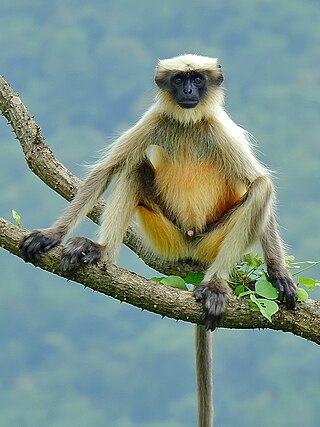
Semnopithecus is a genus of Old World monkeys native to the Indian subcontinent, with all species with the exception of two being commonly known as gray langurs. Traditionally only one species Semnopithecus entellus was recognized, but since about 2001, additional species have been recognized. The taxonomy has been in flux, but currently eight species are recognized.
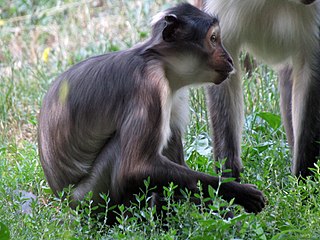
The white-eyelid mangabeys are African Old World monkeys belonging to the genus Cercocebus. They are characterized by their bare upper eyelids, which are lighter than their facial skin colouring, and the uniformly coloured hairs of the fur. The other two genera of mangabeys, Lophocebus and Rungwecebus, were once thought to be very closely related to Cercocebus, so much so that all the species were placed in one genus, but Lophocebus and Rungwecebus species are now understood to be more closely related to the baboons in genus Papio, while the Cercocebus species are more closely related to the mandrill.

The wedge-capped capuchin or Guianan weeper capuchin is a capuchin monkey from South America. It is found in northern Brazil, Guyana and Venezuela. Cebus olivaceus is known to dwell in tall, primary forest and travel over long distances during the day.
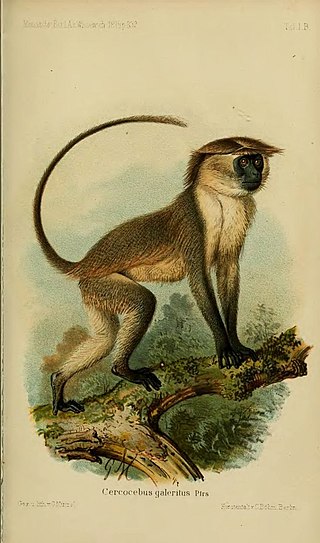
The Tana River mangabey is a highly endangered species of primate in the family Cercopithecidae. Some authorities have included the taxa agilis and sanjei as subspecies of this species, while others award these full species status.
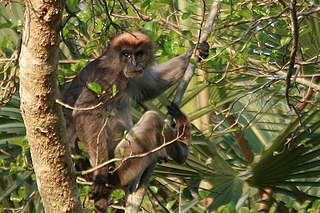
The Tana River red colobus, also called the eastern red colobus, is a highly endangered species of primate in the family Cercopithecidae. It is endemic to a narrow zone of gallery forest near the Tana River in southeastern Kenya.

The olive colobus monkey, also known as the green colobus or Van Beneden's colobus, is a species of primate in the family Cercopithecidae. Its English name refers to its dull olive upperparts. It is the smallest example of all colobine monkeys and is rarely observed in its natural habitat because of its cryptic coloration and secretive nature. It is found in the rain forests of West Africa, ranging from southern Sierra Leone to Nigeria. The IUCN Red List classifies the olive colobus as vulnerable, with the cause of its decline attributed to habitat loss and hunting. Though much of the land within the range of the olive colobus has been affected by human activities, it retains its ability to thrive in small degraded forest fragments.
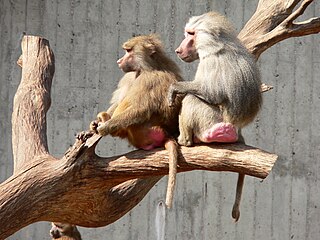
Sexual dimorphism describes the morphological, physiological, and behavioral differences between males and females of the same species. Most primates are sexually dimorphic for different biological characteristics, such as body size, canine tooth size, craniofacial structure, skeletal dimensions, pelage color and markings, and vocalization. However, such sex differences are primarily limited to the anthropoid primates; most of the strepsirrhine primates and tarsiers are monomorphic.

The Ugandan red colobus or ashy red colobus is an endangered species of red colobus monkey, recognised as a distinct species since 2001. There is disagreement however over taxonomy with many considering the Ugandan red colobus to be a subspecies. The Ugandan red colobus is an Old World monkey which is found in five different locations across Uganda and Tanzania.

The agile mangabey is an Old World monkey of the white-eyelid mangabey group found in swampy forests of Central Africa in Equatorial Guinea, Cameroon, Gabon, Central African Republic, Republic of Congo, and DR Congo. Until 1978, it was considered a subspecies of the Tana River mangabey. More recently, the golden-bellied mangabey has been considered a separate species instead of a subspecies of the agile mangabey.
Basic requirements of individual primates include obtaining food, avoiding predators, and reproducing. When these basic requirements are best pursued in the company of others, groups will form. Multi-male groups, also known as multi-male/multi-female, are a type of social organization where the group contains more than one adult male, more than one adult female, and offspring. This structure is characterized by group living, polygynandrous, and strong reproductive competition among males, which could result in an uneven division of male reproductive success. There are no stable heterosexual bonds as both males and females have a number of different mates. Multi-male groups are common among semi-terrestrial primates, like savanna baboons, macques, colobus and some New World monkeys.

Sexual swelling, sexual skin, or anogenital tumescence refers to localized engorgement of the anus and vulva region of some female primates that vary in size over the course of the menstrual cycle. Thought to be an honest signal of fertility, male primates are attracted to these swellings; preferring, and competing for, females with the largest swellings.
Infanticide in non-human primates occurs when an individual kills its own or another individual's dependent young. Five hypotheses have been proposed to explain infanticide in non-human primates: exploitation, resource competition, parental manipulation, sexual selection, and social pathology.

The white-naped mangabey is a species of Old World monkey in the subfamily Cercopithecinae. The species is found in the forest of Burkina Faso, Ghana and Ivory Coast. The species population has been declining due to deforestation and hunting and has thus been put as an endangered species by the International Union for Conservation of Nature. The species was once considered a subspecies of the sooty mangabey but is now a separate species. This species had previously been regarded as a subspecies of Cercocebus atys, but was later raised to species status.



















